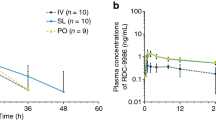Summary
The ingestion of aspartame, a phenylalanine-containing dipeptide, raises plasma phenylalanine levels. These increments are much greater in humans than rats, because the rat hydroxylates phenylalanine five times faster than man. Accordingly, dose comparisons of aspartame (or phenylalanine) between humans and rats have usually been corrected by a factor of five. Recently, a correction factor of sixty has been proposed (Wurtman and Maher, 1987); the rationale is based on a novel calculation of competitive phenylalanine transport into brain. An analysis of the logic behind this postulation reveals there to beno basis for accepting the higher dose conversion of 60 between rat and man.
Similar content being viewed by others
References
Clarke JTR, Bier DM (1982) The conversion of phenylalanine to tyrosine in man. Direct measurement by continuous intravenous tracer infusions of L-[ring-2H5] phenylalanine and L-[1-13C]tyrosine in the postabsorptive state. Metabolism 31: 999–1005
Dailey JW, Lasley SM, Frasca J, Jobe PC (1987) Aspartame (ASM) is not proconvulsant in the genetically epilepsy-prone rat (GEPR). Pharmacologist 29: 142
Filer LJ, Stegink LD (1988) Effects of aspartame on plasma phenylalanine concentration in humans. In: Wurtman RJ, Ritter-Walker E (eds) Dietary phenylalanine and brain function. Birkhauser, Boston, pp 18–40
Fishler K, Asen CG, Henderson R, Friedman EG, Koch R (1987) Psychoeducational findings among children treated for phenylketonuria. Am J Ment Defic 92: 65–73
Gallagher BB (1970) Relationship of phenylalanine to seizure threshold during maturation. J Neurochem 17: 373–380
Garattini S, Caccia S, Romano M, Diomede L, Guiso G, Vezzani A, Salmona M (1988) Studies on the susceptibility to convulsion in animals receiving abuse doses of aspartame. In: Wurtman RJ, Ritter-Walker E (eds) Dietary phenylalanine and brain function. Birkhauser, Boston, pp 131–143
Haigier HJ, Nevins ME, Arnolde SM (1986) Aspartame-lack of effect on convulsant thresholds in mice. J Cell Biol 31: 188
Haley CJ, Harper AE (1978) The importance of transamination and decarboxylation in phenylalanine metabolism in vivo in the rat. Arch Biochem Biophys 189: 524–530
Harper AE (1984) Phenylalanine metabolism. In: Stegink LD, Filer LJ (eds) Aspartame: physiology and biochemistry. Marcel Dekker, New York, pp 77–109
Jobe PC, Bettendorf AF, Lasley SM, Dailey JW (1988) Effects of aspartame on pentylenetetrazole (PTZ)-induced convulsions in CD-1 mice. Toxicologist, in press
Kim KC, Kim SH (1987) Studies on the effect of aspartame and lidocaine interaction in central nervous system in mice. Fed Proc 46: 705
Levy HL, Waisbren SE (1983) Effects of untreated phenylketonuria and hyperphenylalanemia on the fetus. N Engl J Med 309: 1269–1274
Matalon R, Michals K, Sullivan D, Hernandez L, Levy P (1988) Aspartame consumption in normal individuals and carriers for phenylketonuria (PKU). In: Wurtman RJ, Ritter-Walker E (eds) Dietary phenylalanine and brain function. Birkhauser, Boston, pp 41–52
Meldrum B (1987) Lack of effect of L-phenylalanine on photically-induced myoclonus in the baboon,papio papio. Soc Neurosci Abstr 13: 476
Milstein S, Kaufman S (1975) Studies on the phenylalanine hydroxylase system in vivo. An in vivo assay based on the liberation of deuterium or tritium into the body water from ring-labeled L-phenylalanine. J Biol Chem 250: 4782–4785
Pardridge WM, Oldendorf WH (1977) Transport of metabolic substrates through the bloodbrain barrier. J Neurochem 28: 5–12
Pinto JMB, Maher TJ (1986) High dose aspartame lowers the seizure threshold to subcutaneous pentylenetetrazole in mice. Pharmacologist 28: 201
Wagner JG (1979) Drug regiment calculations. In: Wagner JG (ed) Fundamentals of clinical pharmacokinetics. Drug Intelligence Publications, Hamilton, IL, pp 129–172
Wurtman RJ, Maher TJ (1987) Effects of oral aspartame on plasma phenylalanine in humans and experimental rodents. J Neural Transm 70: 169–173
Author information
Authors and Affiliations
Rights and permissions
About this article
Cite this article
Fernstrom, J.D. Oral aspartame and plasma phenylalanine: pharmacokinetic difference between rodents and man, and relevance to CNS effects of phenylalanine. J. Neural Transmission 75, 159–164 (1989). https://doi.org/10.1007/BF01677429
Received:
Accepted:
Issue Date:
DOI: https://doi.org/10.1007/BF01677429




